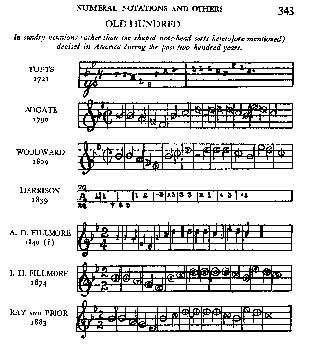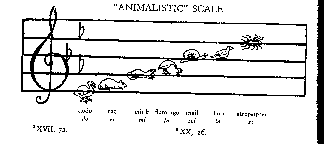Other Music Notations
by Keith Willard
first published in Prairie Harmony Newsletter, Volume 2, #1, January 1991used by permission of author
 figure from p343 White Spirituals in the Southern Uplands
figure from p343 White Spirituals in the Southern UplandsMany other systems than shaped note heads have been developed by Americans to aid the sight singer. The first of these was actually the very first American tune book published on these shores. In 1721 John Tufts brought out a slim book entitled An Introduction to the Singing of Psalm Tunes that used a "letteral" system in which the notes are replaced by the syllables first letter. Andrew Adgate published in 1790 his Philadelphia Harmony in a standard music notation but denoted the scale degree by running lines at different angles through the head. In 1839 Thomas Harrison’s Sacred Harmonicon eliminated standard notation altogether in favor of a form of musical shorthand. Its notes were a succesion of numerals, (middle octave between the lines, lower octave below the bottom line, upper octave above the top line), The length of the basic quarter time was increased by periods before it and decreased by commas under it. The staff was named either A (air), C (counter), D (double air), and B (bass). Key signature and mode were denoted by the figure above the staff label. The Fillmores, father and son, developed a numeral augmentation, consisting of the number of the scale degree. In a variant on Adgate's notation, Ray and Prior developed methods of cross hatching the round note head to denote head shape. A folk tradition related to but distinct from the the southern shaped note currents is the Shaker legacy of music and music notations. These ingenious craftsmen developed a bewildering variety of notations one of which is shown. This is one of the many "letteral" forms they used in which the letters are written cursively. Daniel Patterson in his encyclopedic book The Shaker Spiritual gives a number of beautifully displayed examples. ***
 figure from p344 White Spirituals in the Southern Uplands
figure from p344 White Spirituals in the Southern Uplands